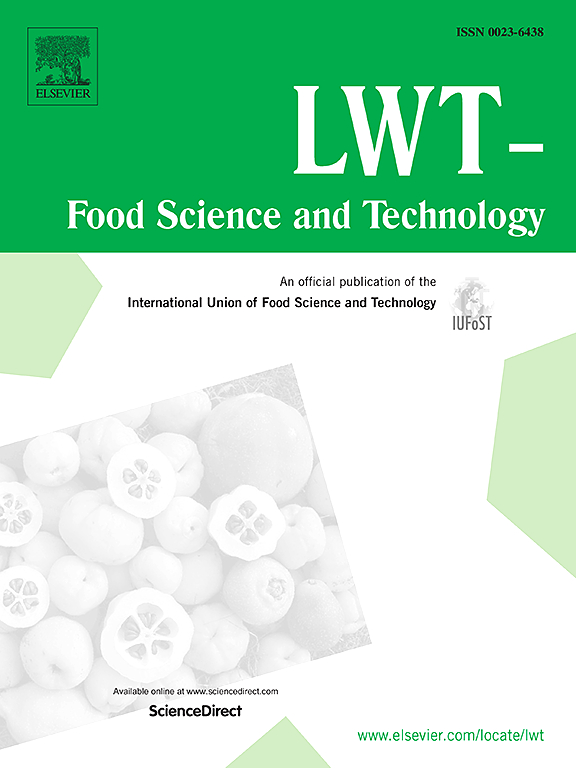装载纳米铜粒子的智能纤维素垫用于实时监测牛肉新鲜度
IF 6
1区 农林科学
Q1 FOOD SCIENCE & TECHNOLOGY
引用次数: 0
摘要
本研究旨在开发一种使用纳米铜粒子(CuNPs)的比色指示剂,以鉴别包装牛肉是否变质。使用浸渍了 CuNPs 的纤维素纸制备了基于 CuNPs 的比色指示剂。稳定性测试表明,基于 CuNPs 的指示剂在 30 天的储存过程中颜色参数没有明显变化。所制备的指示剂对牛肉腐败过程中产生的 H2S 气体具有极好的选择敏感性。制备的指示剂可用于牛肉包装,监测其保质期。经 XPS 分析证实,由于 CuNPs 与硫化物气体发生反应并生成 Cu2S 和 CuS 化合物,基于 CuNPs 的比色指示剂显示出明显的颜色变化,从白色变为棕色。pH 值和菌落总数结果表明,比色指示剂与确定腐败的定性参数之间存在完美的相关性。受损包装中所用指示剂的颜色变化结果表明,指示剂的颜色变化不仅不可逆,而且还能清楚地显示牛肉在贮藏期间的变质阶段。基于 CuNPs 的比色指示剂为肉类产品的智能包装系统提供了用肉眼监测其新鲜度的可行方法。本文章由计算机程序翻译,如有差异,请以英文原文为准。
An intelligent cellulose pad loaded with copper nanoparticles for real-time freshness monitoring of beef
This study aimed to develop a colorimetric indicator using copper nanoparticles (CuNPs) to identify the spoilage of packaged beef. CuNPs-based colorimetric indicators were prepared with cellulose papers impregnated with CuNPs. The stability test showed that the color parameters of the CuNPs-based indicator had no significant color changes during 30 d of storage. The prepared indicator had an excellent and selective sensitivity to H2S gas produced during beef spoilage. The prepared indicator was used in the beef package to monitor its shelf life. The CuNPs-based colorimetric indicator showed noticeable color changes from white to brown due to the reaction of CuNPs with sulfide gases and the production of Cu2S and CuS compounds, confirmed by XPS analysis. The pH and total viable count results indicated a perfect correlation between the colorimetric indicator and the qualitative parameters determining spoilage. The results of the color change of the indicator used in the damaged package showed that not only was the color change of the indicator irreversible, but it also clearly showed the stage of spoilage of the beef during its storage. The CuNPs-based colorimetric indicator provides a promising approach in intelligent packaging systems of meat products to monitor their freshness with the naked eye.
求助全文
通过发布文献求助,成功后即可免费获取论文全文。
去求助
来源期刊

LWT - Food Science and Technology
工程技术-食品科技
CiteScore
11.80
自引率
6.70%
发文量
1724
审稿时长
65 days
期刊介绍:
LWT - Food Science and Technology is an international journal that publishes innovative papers in the fields of food chemistry, biochemistry, microbiology, technology and nutrition. The work described should be innovative either in the approach or in the methods used. The significance of the results either for the science community or for the food industry must also be specified. Contributions written in English are welcomed in the form of review articles, short reviews, research papers, and research notes. Papers featuring animal trials and cell cultures are outside the scope of the journal and will not be considered for publication.
 求助内容:
求助内容: 应助结果提醒方式:
应助结果提醒方式:


